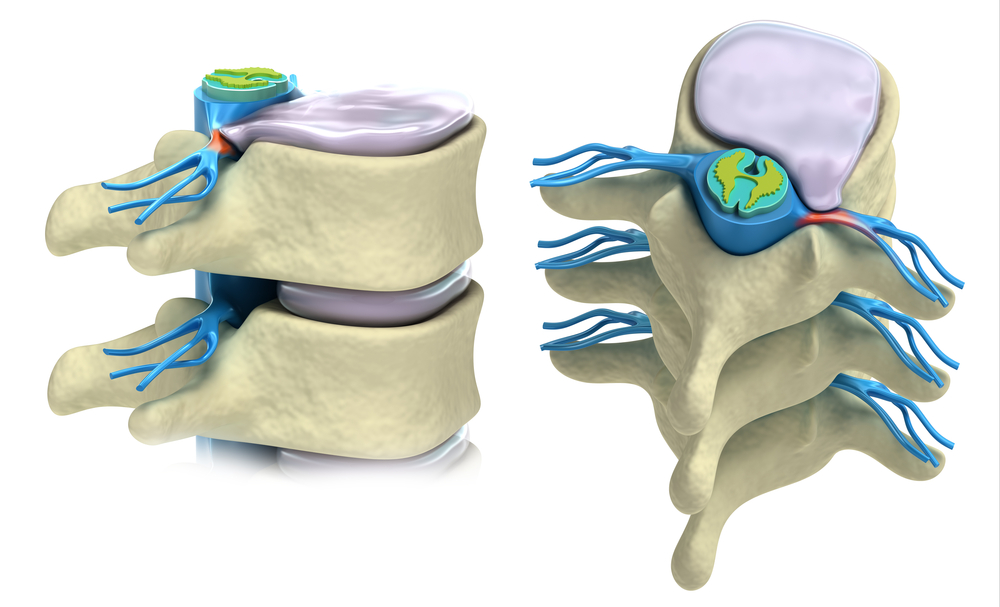The main reason people visit a chiropractor is to address complaints of back and neck pain. In many cases, this is minor and easily alleviated with regular chiropractic adjustments, but some conditions may be more severe. Disc herniation is one example of a condition that can become serious and even need more invasive or surgical treatment. However, when chiropractic adjustments are started early and done regularly, they can help remediate the symptoms of disc herniation and give a better outlook for complete healing.
What Is a Herniated Disc?
The spine is not a single bone, but rather a column of vertebrae that stack on top of one another. Besides the top two vertebrae in the neck (C1 and C2), each vertebra is separated by a cushion-like disc. This acts as a shock absorber and shock distributor, providing flexibility and preventing the bone from rubbing together. Think about if you were to jump up and down right now- without these discs, your vertebrae would crash into each other, causing pain.
These discs are made up of an outer layer and a soft, gel-like center. Cracks in the tough outer layer can allow the material inside to begin spilling out. Discs can also move out of place in response to trauma or car accident injury. Either of these things happening allows the disc to press against the nerve roots surrounding the spine, causing pain, numbness, tingling, or other symptoms.
Herniated discs can occur for a variety of reasons. The most common is simple wear and tear brought on by age and physical activity, where the discs simply degenerate and become more susceptible to these problems. Poor posture and being overweight can also put extra pressure on these discs. In other cases, a physical change or trauma can cause disc herniation. A car accident may knock your vertebrae and discs out of alignment for example. A strong sneeze or cough can even lead to this problem if you’re at just the right angle.
Chiropractic Care for Disc Herniation
If you suffer a herniated disc, you will notice pain or other symptoms at some point, which may lead you to the chiropractor. Their job is to evaluate the entire spine and correct any misalignments, including the discs. At your first appointment, a chiropractor will likely review your medical history, do a physical examination, and perform other tests based on your account of your symptoms.
Chiropractors will be looking for certain things when they perform tests, including:
- Are your reflexes intact? That is to say: are your nerves sending messages as they should? This may be a classic reflex test, like when the doctor hits your knee with a small hammer to ensure the leg moves.
- Is there a loss of muscle strength? Do your muscles appear to be wasting?
- Have you lost sensation along the path of a nerve?
What diagnostic tests should you get after an accident that may have caused disc herniation? Depending on these results, your doctor may order an x-ray or MRI to help with diagnosis. With this information, they will be able to determine the overall functioning of your spine and what issues, including disc herniation, may be present. They can then determine what types of chiropractic treatment will best solve your issues and develop a treatment plan.
Chiropractic Techniques for Herniated Discs
Doctors will primarily use classic spinal manipulation and adjustments to resolve your disc herniation. However, they may also use other techniques to address serious conditions in a less invasive manner than surgery.
Flexion-distraction Technique: This uses a specialized table to gently distract, or stretch, the spine. The chiropractor can then isolate the impacted area and flex the spine using a pumping rhythm. This is generally painless and allows the center of the disc to resume its central position while moving discs away from the nerve. Flexion-distraction usually requires multiple sessions and supplemental exercises to reach full alignment.
Manipulation Under Anesthesia: Also known as MUA, this is performed at an outpatient center or hospital. You will be put under twilight sleep, a short version of being put under, while the chiropractor stretches and manipulates your body while it is in a relaxed state. 1 to 3 sessions are usually needed for the best results.
Pelvic Blocking Techniques: This uses cushioned wedges, placed under each side of the pelvis, along with gentle exercises to change the mechanics of your spine. Discs are then drawn away from the nerve.
These techniques are all extremely effective in healing disc herniation and preventing the need for more invasive treatments and surgeries. If you think you may have a herniated disc, visit a chiropractor today to begin recovery.




